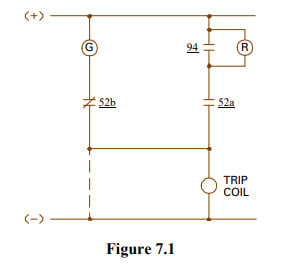Haikuheros
Electrical
Hello World! I'm trying to get an understanding of an actual product to use for the Red lamp in Figure 7.1. The figure came from a relay trip circuit design pdf. [] The document describes the red lamp as a 24V, I think incandescent, bulb with a series resistance. Is there a rule of thumb for the series resistance that's used here to ensure the lamp lights but the coil doesn't trip? Is there an industry defacto standard light that exists with an integrated resistance?
It also suggests that LED lamps can be used but it needs to be designed to have sufficient draw to not light under a high resistance such as a burned-open trip coil. What do they mean by sufficient draw? Are there standard COTS light assemblies used for this purpose or is it just any old panel indicator with some resistance added to it?

Thanks,
David
It also suggests that LED lamps can be used but it needs to be designed to have sufficient draw to not light under a high resistance such as a burned-open trip coil. What do they mean by sufficient draw? Are there standard COTS light assemblies used for this purpose or is it just any old panel indicator with some resistance added to it?

Thanks,
David
